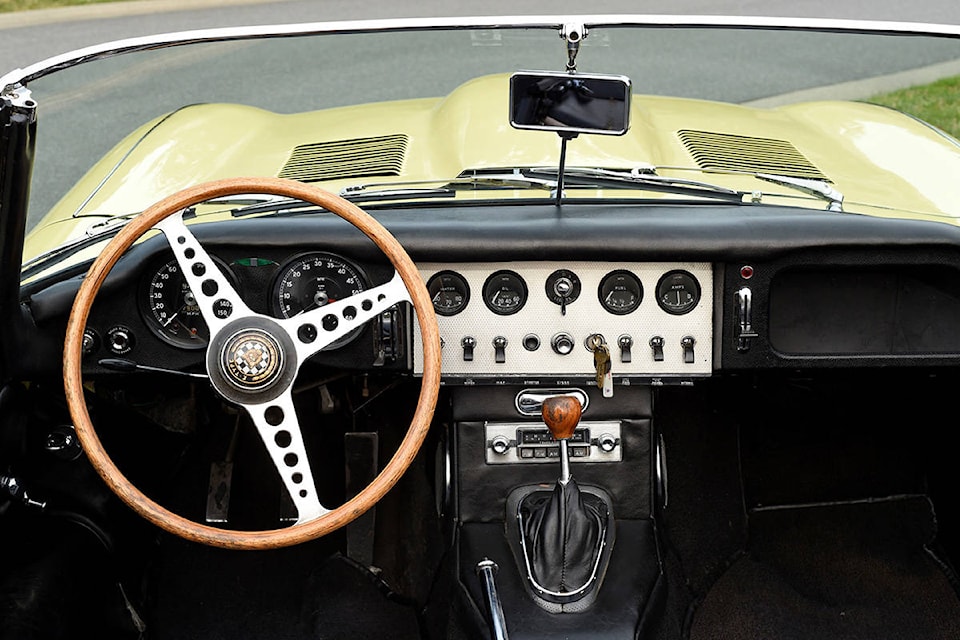- Story by Sean McIntyre Photography by Don Denton
From West Shore Life + Style
It takes a specific combination of factors to create the perfect drive. When you’re driving a 1961 Series 1 Jaguar E-Type roadster, the hills shouldn’t be too steep, the curves should be many and the traffic should be fast and light.
David Moisik is fortunate enough to have just such roads only a few minutes from his Colwood home.
| Photography by Don Denton |
“Metchosin’s Kangaroo Road is one of these roads that is constantly curving and has just the right combination of turns and hills that makes driving the E-Type roadster so much fun with the top down. You can smell the forest and feel the wind blow through your hair,” David says. “Highways aren’t necessarily a lot of fun in a car like this. When you’re in an open car, you don’t really want to be flying down the highway with enormous semis that you can practically drive under on both sides.”
Drives like Kangaroo Road and East Sooke Road are the kind of places one is likely to come across fellow Jaguar enthusiasts out for a “Sunday prowl” through West Shore communities and beyond. David says it’s coastal roads like this that explains why many classic car aficionados decide to settle in southern Vancouver Island.
“We call this area classic car heaven because of the roads and the weather,” he says.
Though he’s been enjoying the rewards of life in classic car heaven for a few years, David’s relationship with his E-Type Jag began four decades ago and 2,000 kilometres to the east in Regina, Saskatchewan, where the young architect spotted a used model at a local detailing shop in the late ’70s. David had become infatuated with this type of car years earlier at age nine, when he spotted a sparkling new 1961 model in the Regina Jaguar showroom.
“It was love at first sight,” he recalls. “It was a magnificent yellow roadster and the salesman made it clear to look but not touch. I made a promise to myself that one day I would own an E-Type.”
David instantly made an offer, but it took the car’s owner over a year to finally agree to sell the car. The original owner’s sudden change of heart was terrific news to David. Fortunately, David — who was living in an apartment at the time — had a very generous mom who agreed to park her Toyota outside, where it would endure the harsh prairie winter, while the Jag stayed snug in her garage. She also thought it was a car unlike any other.
The Series 1 3.8 Jaguar E-Type rolled off the assembly line from 1961 until October 1964 with the E-Type’s final Series 3 car made in September 1973. Automotive journalists of the day were quick to hail the car as a design triumph that mixed beauty and high performance. The car’s 3.8-litre engine produced 265 horsepower with a top speed clocked in at 241 km/h, and it was capable of going from zero to 100 km/h in under seven seconds.
So impressive was the car, that none other than master car designer Enzo Ferrari lauded the 1961 E-Type as the most beautiful car ever made.
In 1996, the car was added to the New York Museum of Modern Art’s permanent design collection whose curator, Christopher Mount, said, “The car’s beauty and overall harmony of line arises from the designer basing its form on the ellipse, giving it a universality of the mathematical proportions, which by definition are not subjective but absolute.”
| Photography by Don Denton |
The model was based on a Jaguar race car that had been tearing up the track and smashing records in the 1950s, including three consecutive victories at the annual 24 Hours of Le Mans auto race, considered the world’s most prestigious automotive race and often called the “Grand Prix of Endurance and Efficiency.”
“The technology was really a racing-car technology,” David says. “It was famous for being a fast car with tremendous handling.”
The design of the Series 1 E-Type roadster’s lightweight monocoque structure was inspired by aircraft-design principles and used elliptical mathematical curves to maximize its aerodynamic performance. It’s exactly those smooth lines that David finds visually exciting even four decades after he brought it home for the first time.
Now, it’s long been part of the family, he says. When his kids were born in the 1980s, David set out to rebuild and restore his aging treasure, dissembling and then reassembling it over many years. As he and his wife, Susan, raised their two children, David recalls using discarded baby food jars to store all the nuts, bolts, gaskets and other parts that were accruing on the garage floor. As they grew older, David’s kids were slowly able to piece together the task that infatuated their father for so long.
“For the first number of years, my kids didn’t know what it was,” he says, “I don’t think they actually knew what the car looked like or what it was until they were nine or 10. All the parts sat in our garage for years and years” until one day David took it all to a Jaguar shop where it was reassembled over a 4-year period.
And what a car it’s become.
| Photography by Don Denton |
Did you know:
Kudos for the car: Sports Car International magazine ranked the car in top spot in its 2004 list of the top sports cars of the 1960s, and the Jaguar E-type ranked first in a list of the world’s most beautiful cars by the Daily Telegraph in 2008.
The E-Type Roadster was the car of choice for the international man of mystery in the Austin Powers film series. More recently, Don Draper took the car for a spin in the popular Mad Men television series.



